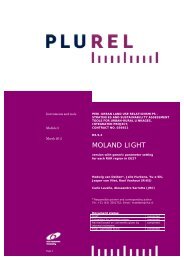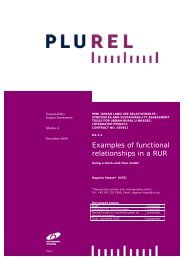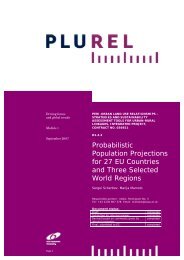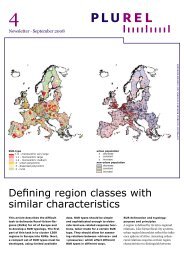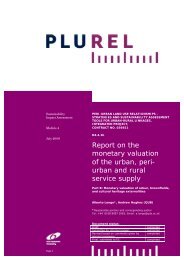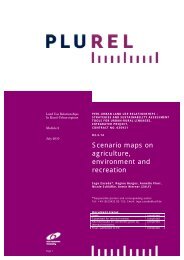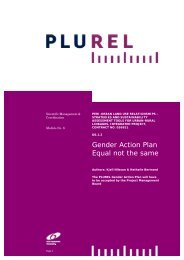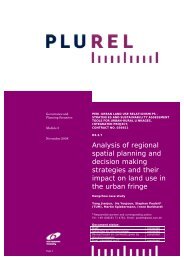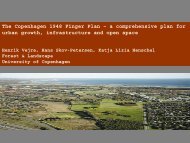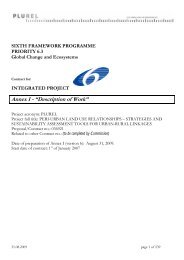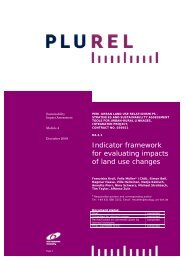Cost benefit analysis of peri-urban land use policy - Plurel
Cost benefit analysis of peri-urban land use policy - Plurel
Cost benefit analysis of peri-urban land use policy - Plurel
Create successful ePaper yourself
Turn your PDF publications into a flip-book with our unique Google optimized e-Paper software.
operation costs, travel time, accident costs, area property values 16 ), transportation<br />
network effects (operating costs and revenues <strong>of</strong> metro), and energy and environmental<br />
impacts (CO 2 emissions and local area pollution), as suggested by the international<br />
literature. Data limitations for the impact evaluation <strong>of</strong> rapid rail investments in the GDA<br />
are also influential in the process <strong>of</strong> the selection <strong>of</strong> indicators. Metro North project is<br />
selected for the scenario-based impact assessment in this study, considering its wide<br />
impacts in the GDA and in particular, data availability for this project published in<br />
various sources.<br />
From the literature review, there are few studies with a capacity <strong>of</strong> incorporating all <strong>of</strong> the<br />
possible externalities into their <strong>analysis</strong>. This stems from the fact that it is difficult to<br />
quantify most <strong>of</strong> the impacts <strong>of</strong> transportation provisions. Some <strong>of</strong> the impacts and<br />
indicators can be represented in monetary values while others can be only expressed in a<br />
qualitative way. There may be also correlations among various indicators such as the<br />
positive correlation between <strong>land</strong>-<strong>use</strong> accessibility and <strong>land</strong> values, or the negative<br />
correlation between air pollution exposure and area property values. Considering the<br />
correlation effects, data limitations and the marginal role <strong>of</strong> some specific impacts in<br />
CBA, only a limited number <strong>of</strong> indicators are selected in the present <strong>analysis</strong>.<br />
Implementation <strong>of</strong> CBA for Impact Evaluation <strong>of</strong> Metro North<br />
Investment in the GDA<br />
Scenario <strong>analysis</strong>- comprising a baseline scenario (reference scenario) which is compared<br />
with several alternative scenarios- can construct a base for the impact evaluation <strong>of</strong> rapid<br />
rail investments. The research is mainly based on the consideration <strong>of</strong> two scenarios: A<br />
baseline-business-as-usual and alternative with rail scenarios. According to the baseline<br />
scenario, it is assumed that the <strong>urban</strong> area would continue to grow with the present<br />
trends and there would be only sufficient maintenance and renewal investments to<br />
maintain the existing infrastructure (see Figure 4). Therefore rail services in future years<br />
would be broadly comparable to the current level leading to a dispersed form.<br />
16 In relation to area property values, there are two key points to highlight: First, the <strong>land</strong> valuegains<br />
accrue to private property owners to a large extent. Second, it is important to mention the<br />
existence <strong>of</strong> relocation effects stemming from local development i.e. the gain achieved by one<br />
area may be lost in another area in the region implying a net zero effect overall. Therefore, it is<br />
suggested that effects on local development reflected in adjusted property values are not to be<br />
taken into account in CBA but can be evaluated separately subject to a qualitative assessment.<br />
73



